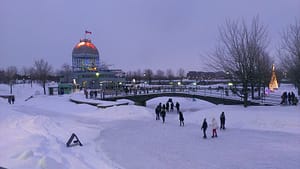Montréal’s reputation for effervescent nightlife reaches back to the Roaring Twenties—specifically, to the 13-year period of Prohibition in the U.S. from 1920 to 1933. Americans streamed into Montréal for relief from alcohol deprivation (while Canadian distillers and brewers made fortunes). Montréal already enjoyed a sophisticated and slightly naughty reputation as the Paris of North America, which added to the allure.
Nearly a century later, packs of Americans still travel across the border to go to the city’s bars and strip clubs (as do Canadians from other provinces) for bachelor and bachelorette weekends. Clubbing and barhopping are hugely popular activities, and nightspots stay open until 3am—much later hours than in many U.S. and Canadian cities, which still heed Calvinist notions of propriety and early bedtimes. The legal drinking age is also only 18.
That said, the city’s nocturnal pursuits are often as sophisticated and edgy as anywhere else. The city is on the standard concert circuit, so internationally known entertainers, music groups, and dance companies pass through. A French enthusiasm for film, as well as the city’s reputation as a movie-production center, ensures support for film festivals and screenings of offbeat and independent movies.
Vieux-Montréal, especially along rue St-Paul, has a universal quality, with many of its bars and clubs showcasing live jazz, blues, and folk music. The Little Burgundy hub, west of Vieux-Montréal, has a sophisticated mix of bars and restaurants.
Quartier des Spectacles is where many of the performing arts venues are located. It’s also where many of the outdoor festivals take place.
In Plateau Mont-Royal, boulevard St-Laurent, known locally as “the Main,” is a miles-long haven of hip and hipster restaurants and clubs. It starts roughly from rue Sherbrooke and goes all the way north into Mile End to rue Laurier. It’s a good place to wind up in the wee hours, as there’s always someplace with the welcome mat still out, even after the official 3am closings. If you’ve still got steam after that, there are after-hours dance clubs in the Gay Village. Rue Ste-Catherine est in the Village closes in summer to cars and becomes flush with people as the cafes and bars that line the street build temporary terraces.
Downtown’s parallel blocks of rue Crescent, rue Bishop, and rue de la Montagne north of rue Ste-Catherine are where much of the city’s hard-core partying takes place, with rows of bars with outdoor terraces. Especially on summer weekend nights, the streets swarm with people careening from bar to restaurant to club. It’s young and noisy—and also considered to be a tourist trap to locals, although many still end up there. This area has a pronounced Anglophone (English-speaking) character.
Francophones dominate the area known as the Quartier Latin, with college-age patrons most evident along the lower reaches of rue St-Denis, and their elders gravitating to the nightspots on the slightly more uptown blocks of the same street.
Most bars and clubs don’t charge a cover, and when they do, it’s rarely more than C$10. Happy hour is locally known as cinq à sept, although many venues offer specials that start earlier than 5pm and go later than 7pm. On Thursdays, many bars and restaurants offer some sort of food and drink special.

